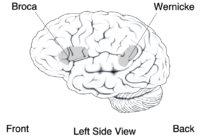
Photo from wikipedia
To seek information on delirium assessment processes and pathways in non-intensive clinical care settings in the United Kingdom (UK), and to assess usage of specific delirium assessment tools: the 4… Click to show full abstract
To seek information on delirium assessment processes and pathways in non-intensive clinical care settings in the United Kingdom (UK), and to assess usage of specific delirium assessment tools: the 4 'A's Test (4AT), Confusion Assessment Method and Single Question to identify Delirium (SQiD). In total, 95% of National Health Service (NHS) units (hospitals, trusts and health boards) reported use of formal delirium assessment processes and 85% of units had guidelines or pathways in place. The 4AT was the most widely used tool, with 80% of units reporting use; the Confusion Assessment Method was reportedly used in 45% of units and the SQiD in 36% of units. This study shows real-world, large-scale uptake of delirium detection methods and delirium guidelines in UK hospitals, which contributes to ongoing efforts to improve delirium care. Our aim was to collect information on delirium assessment processes and pathways in non-intensive care settings in the United Kingdom (UK). We sent a Freedom of Information request to 169 UK National Health Service (NHS) hospitals, trusts and health boards (units) in July 2020 to obtain data on usage of delirium assessment tools in clinical practice and delirium pathways or guidelines. We received responses from 154/169 units (91% response rate). Of these, 146/154 (95%) units reported use of formal delirium assessment processes and 131/154 (85%) units had guidelines or pathways in place. The 4’A’s Test (4AT) was the most widely used tool, with 117/146 (80%) units reporting use. The Confusion Assessment Method was used in 65/146 (45%) units, and the Single Question to identify Delirium (SQiD) in 52/146 (36%) units. Our findings show that the 4AT is the most commonly used tool in the UK, with 80% of units reporting use. This study adds to our knowledge of real-world uptake of delirium detection methods at scale. Future studies should evaluate real-world implementation of delirium assessment tools further via (1) tool completion rates and (2) rates of positive scores against the expected of prevalence delirium in the clinical population concerned.
Journal Title: European Geriatric Medicine
Year Published: 2021
Link to full text (if available)
Share on Social Media: Sign Up to like & get
recommendations!